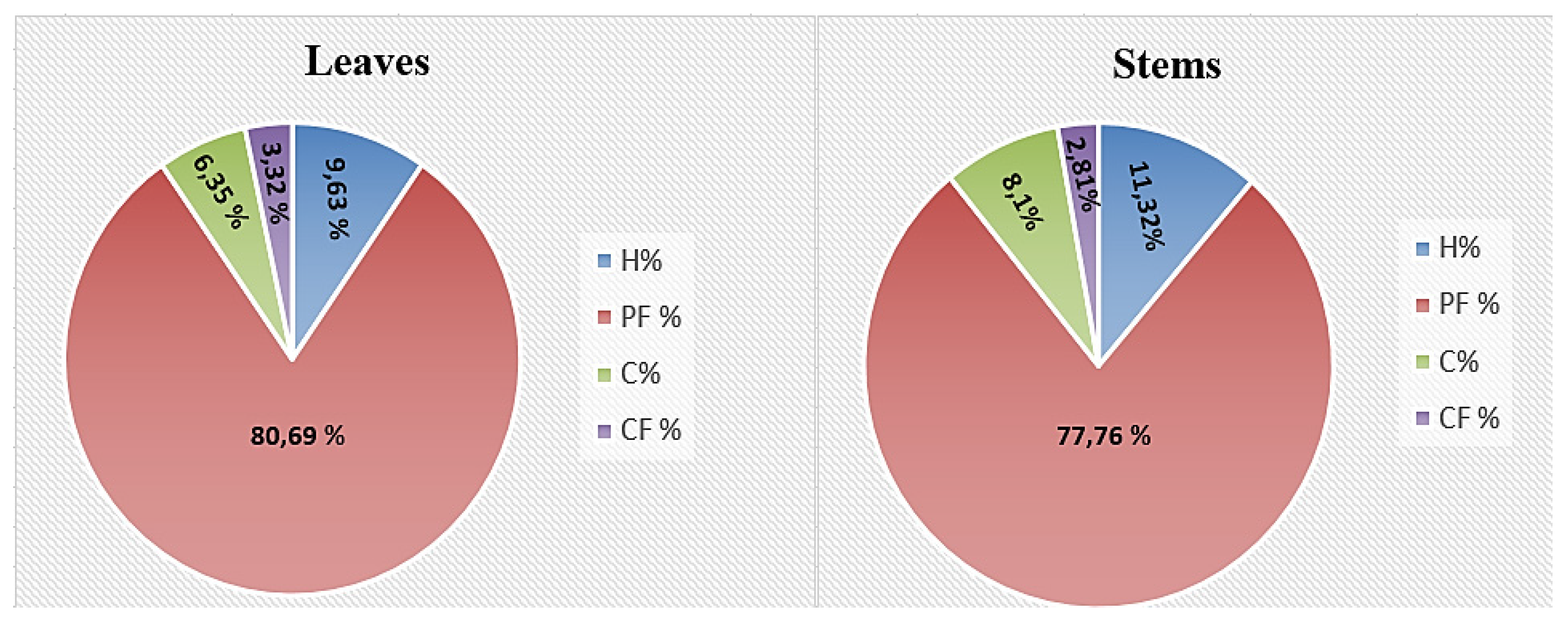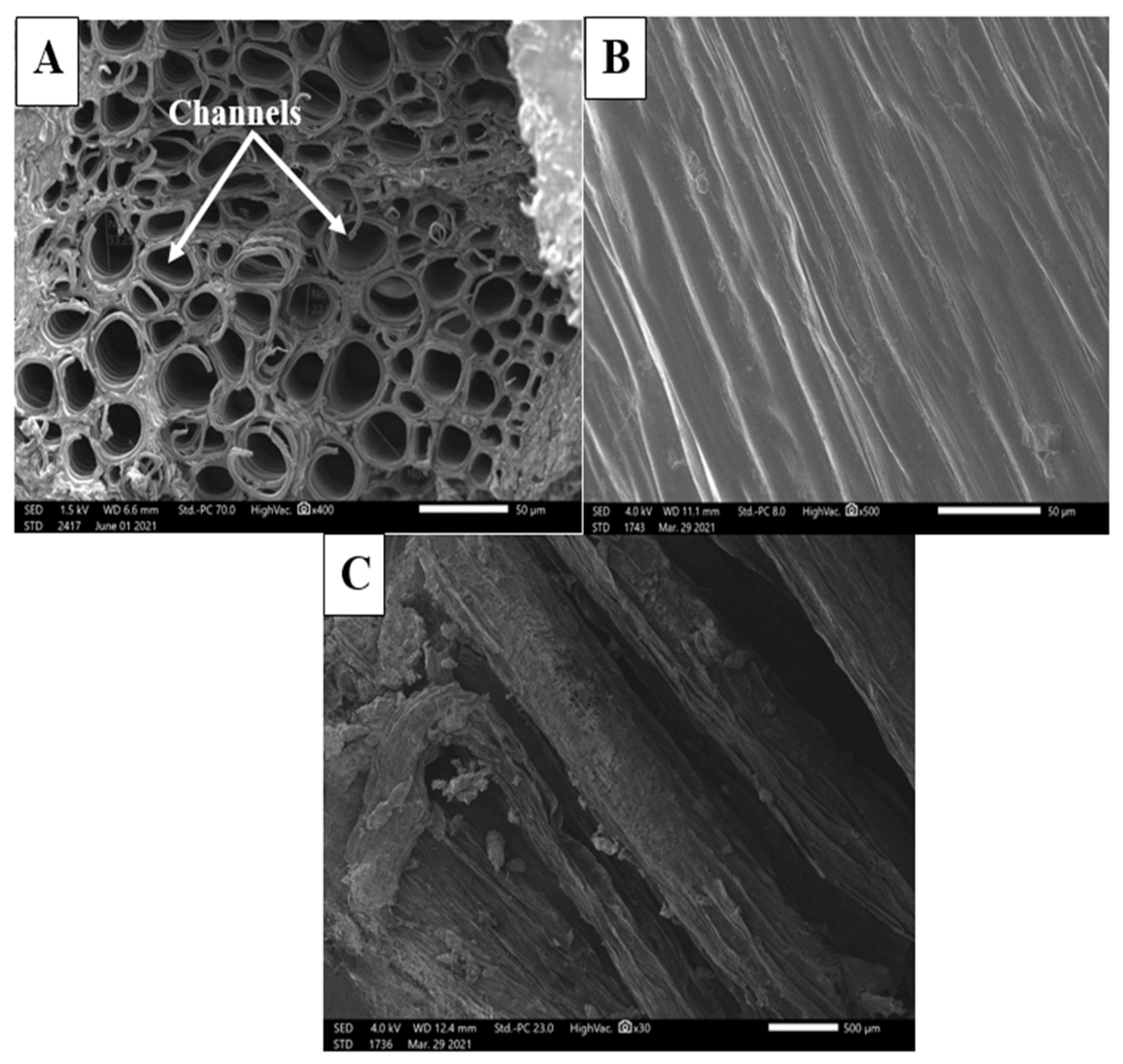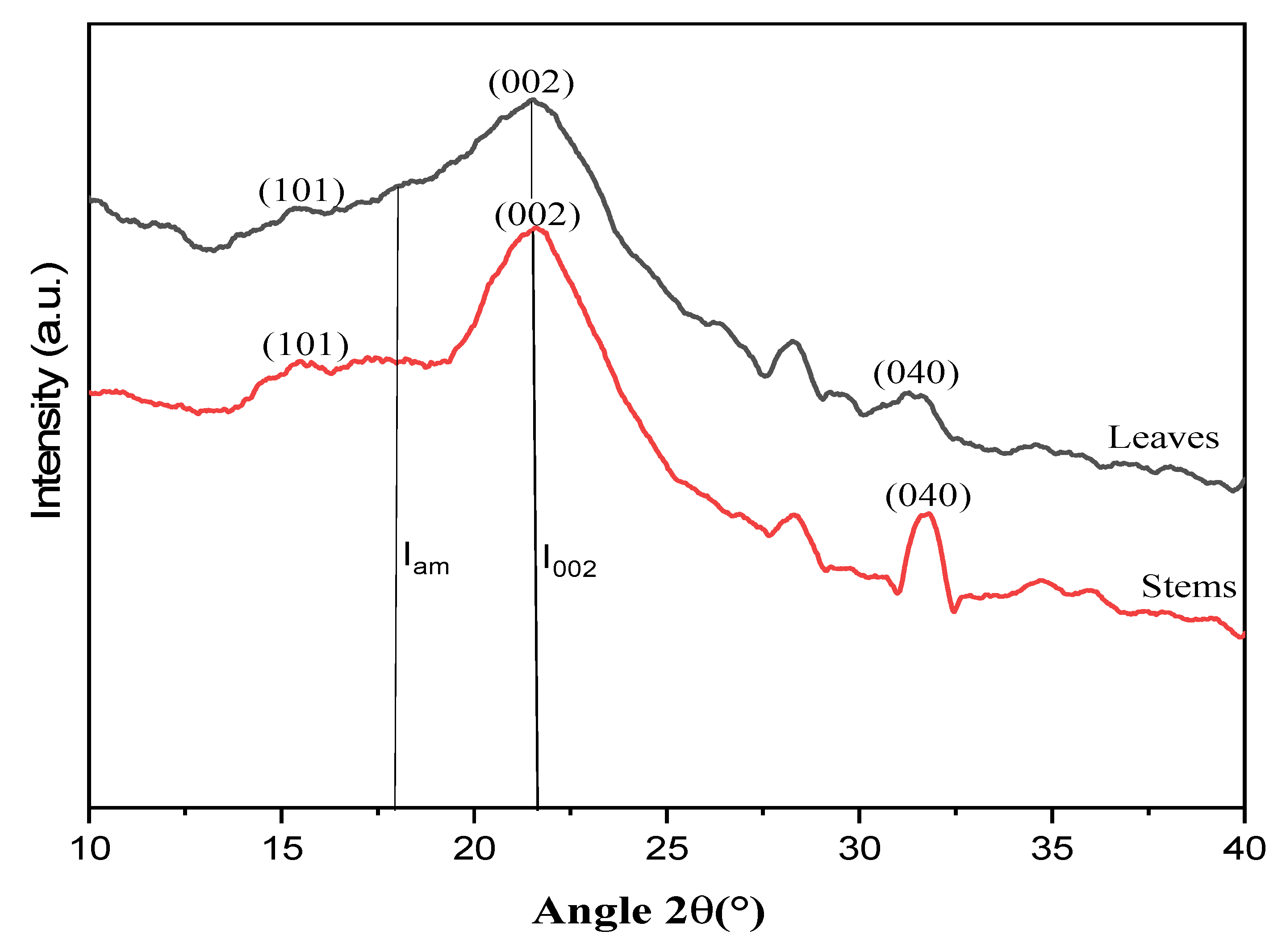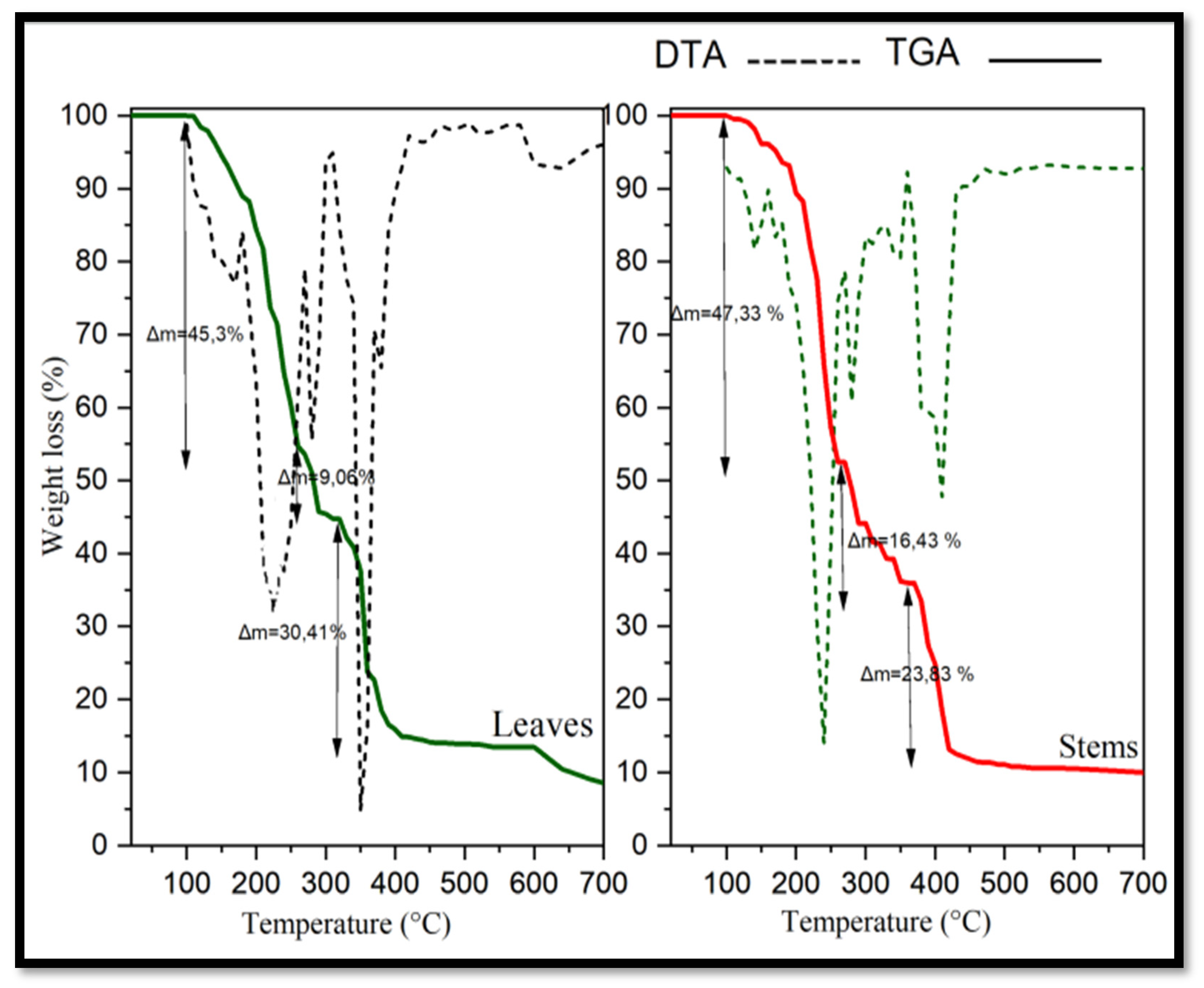Physicochemical Characterization of Cardoon “Cynara cardunculus” Wastes (Leaves and Stems): A Comparative Study
Abstract
:1. Introduction
2. Materials and Methods
2.1. Materials
- a.
- Cardoon wastes
- b.
- Chemicals
2.2. Methods
2.2.1. Preliminary Analyses
- a.
- Moisture and volatile matter contents
- m1 is the mass of the sample after drying at 105 °C.
- m2: mass of the sample after treatment at 1000 °C.
- b.
- Ash content
- c.
- Fixed carbon
2.2.2. Determination of Surface Functions and pH at Point Zero Charge
- a.
- Acid-base character: Boehm’s method
- Protocol for the determination of basic functions
- Protocol for the determination of the acid functions
- b.
- Determination of pH point at zero charge (pHPZC)
2.2.3. Physicochemical Characterization
- a.
- Scanning electron microscopy coupled to EDX (SEM/EDX)
- b.
- X-ray diffraction (XRD) analysis
- c.
- Fourier Transform Infrared Spectroscopy (FTIR)
- d.
- Inductively coupled plasma atomic emission spectroscopy (ICP-AES)
- e.
- Thermogravimetric analysis (TGA/DTA)
3. Results and Discussion
3.1. Preliminary Analyses
3.2. Determination of Surface Functions and pH at Point Zero Charge
- a.
- Acid-base character: Boehm’s method
- b.
- Determination of pH point at zero charge (pHPZC)
3.3. Physicochemical Characterizations
- a.
- Scanning electron microscopy coupled to EDX (SEM/EDX)
- b.
- X-ray diffraction (XRD)
- I002: the maximum intensity of the diffraction peak of (200) plane
- Iam: the intensity of the amorphous band at 2θ = 18°.
- c.
- Fourier Transform Infrared Spectroscopy (FTIR)
| Wavenumber (cm−1) | Assignment [19,20] | |
|---|---|---|
| Leaves | Stems | |
| 3300 | 3300 | H-O (cellulose) |
| 2922 | 2922 | C-H (CH2) (cellulose/hemicellulose) |
| 2852 | 2852 | C-H (cellulose) |
| 1730 | 1730 | C=O (carboxylic acid /ester) hemicellulose |
| 1600 | 1600 | O-H (cellulose) |
| 1407 | 1407 | C-H (cellulose) |
| 1367 | 1367 | C-H (cellulose) |
| 1320 | 1315 | O-H (cellulose) |
| 1251 | 1250 | C-O (the ester) |
| 1020 | 1024 | C-O (cellulose/hemicellulose) |
| 815 | 817 | C-H (glycosidic cycle) |
| 770 | 775 | C-H (aromatic ring) |
- d.
- Inductively coupled plasma atomic emission spectroscopy (ICP-AES)
- e.
- Thermogravimetric analysis (TGA/DTA)
- -
- The first step: of 45.3% occurs around 230 °C and was attributed to the departure of volatile matter.
- -
- -
4. Conclusions
Author Contributions
Funding
Institutional Review Board Statement
Informed Consent Statement
Data Availability Statement
Acknowledgments
Conflicts of Interest
References
- El Hajam, M.; Plavan, G.I.; Idrissi Kandri, N.; Dumitru, G.; Nicoara, M.N.; Zerouale, A.; Faggio, C. Evaluation of Softwood and Hardwood Sawmill Wastes Impact on the Common Carp “Cyprinus Carpio” and Its Aquatic Environment: An Oxidative Stress Study. Environ. Toxicol. Pharmacol. 2020, 75, 1–9. [Google Scholar] [CrossRef] [PubMed]
- Nya, I. La Modernisation Du Processus de Gestion Des Déchets Au Maroc: Miracle Ou Mirage? Revue Internationale des Sciences de Gestion 2020, 3, 389–407. [Google Scholar]
- El Hajam, M.; Idrissi Kandri, N.; Plavan, G.I.; Harrath, A.H.; Mansour, L.; Boufahja, F.; Zerouale, A. Pb2+ Ions Adsorption onto Raw and Chemically Activated Dibetou Sawdust: Application of Experimental Designs. J. King Saud Univ.-Sci. 2020, 32, 2176–2189. [Google Scholar] [CrossRef]
- El Hajam, M.; Idrissi Kandri, N.; Harrach, A.; El Khomsi, A.; Zerouale, A. Adsorption of Methylene Blue on Industrial Softwood Waste “Cedar” and Hardwood Waste “Mahogany”: Comparative Study. Mater. Today Proc. 2019, 13, 812–821. [Google Scholar] [CrossRef]
- Galletti, A.M.R.; Domenico, L.; Serena, C.; Nicola, D.F.; Valentina, C.; Franco, C.; Claudia, A. Sustainable exploitation of residual Cynara cardunculus L. to levulinic acid and n-butyl levulinate. Catalysts 2021, 11, 1082. [Google Scholar] [CrossRef]
- Gominho, J.; Curt, M.D.; Lourenço, A.; Fernández, J.; Pereira, H. Cynara cardunculus L. as a Biomass and Multi-Purpose Crop: A Review of 30 Years of Research. Biomass Bioenergy 2018, 109, 257–275. [Google Scholar] [CrossRef]
- AFNOR XP CENT/TS 14774-3. Normes Natl. Doc. Normatifs Natx. 2005, 1–11. Available online: https://www.boutique.afnor.org/fr-fr/norme/xp-cen-ts-147743/biocombustibles-solides-methode-de-determination-de-la-teneur-en-humidite-m/fa123684/59652 (accessed on 23 November 2021).
- AFNOR XP CENT/TS 15148. Normes Natl. Doc. Normatifs Natx. 2006, 1–16. Available online: https://www.boutique.afnor.org/fr-fr/norme/xp-cen-ts-15148/biocombustibles-solides-methode-pour-la-determination-de-la-teneur-en-matie/fa120666/59562 (accessed on 23 November 2021).
- AFNOR XP CENT/TS 14775. Normes Natl. Doc. Normatifs Natx. 2005, 1–13. Available online: https://www.boutique.afnor.org/fr-fr/norme/xp-cen-ts-14775/biocombustibles-solides-methode-de-determination-de-la-teneur-en-cendre/fa120667/59564 (accessed on 23 November 2021).
- Ovo Augou, S.F.; Ouattara, S.; Serifou, M.A.; Kouakou, C.H.; Djohore, A.C.; Emeruwa, E. Influence de La Teneur En Amidon de Manioc Sur La Qualité d’un Biocharbon à Base de Sciure de Bois et d’amidon de Manioc. Rev. RAM Res. SAI 2020, 1, 1–5. [Google Scholar]
- Boehm, H.P. Some Aspects of the Surface Chemistry of Carbon Blacks and Other Carbons. Carbon 1994, 32, 759–769. [Google Scholar] [CrossRef]
- Reymond, J.P.; Kolenda, F. Estimation of the Point of Zero Charge of Simple and Mixed Oxides by Mass Titration. J. Collold Interface Sci. 1989, 130, 157–164. [Google Scholar] [CrossRef]
- Rivera-Utrilla, J.; Bautista-Toledo, I. Activated Carbon Surface Modifications by Adsorption of Bacteria and Their Effect on Aqueous Lead Adsorption. J. Chem. Technol. Biotechnol. 2001, 76, 1209–1215. [Google Scholar] [CrossRef] [Green Version]
- Pinta, M. Méthodes de Référence pour la détermination des éléments minéraux dans les végétaux. Determination des éléments Ca, Mg, Fe, Mn, Zn et Cu par Absorption Atomoque. Oléagineux 1973, 28, 87–92. [Google Scholar]
- Grammelis, P.; Malliopoulou, A.; Basinas, P.; Danalatos, N.G. Cultivation and Characterization of Cynara Cardunculus for Solid Biofuels Production in the Mediterranean Region. Int. J. Mol. Sci. 2008, 9, 1241–1258. [Google Scholar] [CrossRef] [PubMed]
- Damartzis, T.; Vamvuka, D.; Sfakiotakis, S.; Zabaniotou, A. Thermal Degradation Studies and Kinetic Modeling of Cardoon (Cynara cardunculus) Pyrolysis Using Thermogravimetric Analysis (TGA). Bioresour. Technol. 2011, 102, 6230–6238. [Google Scholar] [CrossRef] [PubMed]
- Ouldmoumna, A.; Reinert, L.; Benderdouche, N.; Bestani, B.; Duclaux, L. Characterization and Application of Three Novel Biosorbents “Eucalyptus Globulus, Cynara Cardunculus, and Prunus Cerasefera” to Dye Removal. Desalin. Water Treat. 2013, 51, 3527–3538. [Google Scholar] [CrossRef]
- Segal, L.; Creely, J.J.; Martin, A.E.; Conrad, C.M. An Empirical Method for Estimating the Degree of Crystallinity of Native Cellulose Using the X-Ray Diffractometer. Text. Res. J. 1959, 29, 786–794. [Google Scholar] [CrossRef]
- Rana, A.K.; Basak, R.K.; Mitra, B.C.; Lawther, M.; Banerjee, A.N. Studies of Acetylation, of Jute Using Simplified Procedure and Its Characterization. J. Appl. Polym. Sci. 1997, 64, 1517–1523. [Google Scholar] [CrossRef]
- Larkin, P. IR and Raman Spectroscopy; British Library: Waltham, MA, USA, 2011; pp. 1–239. [Google Scholar]
- Angelova, V.; Nemska, M.P.; Uzunova, G.; Krustev, L. Chemical Composition of Cardoon (Cynara cardunculus L.) Grown in South Bulgaria. Agrofor Int. J. 2019, 4, 100–110. [Google Scholar]
- Dorez, G.; Ferry, L.; Sonnier, R.; Taguet, A.; Lopez-Cuesta, J.M. Effect of Cellulose, Hemicellulose and Lignin Contents on Pyrolysis and Combustion of Natural Fibers. J. Anal. Appl. Pyrolysis 2021, 107, 323–331. [Google Scholar] [CrossRef]
- Yang, H.; Yan, R.; Chen, H.; Lee, D.H.; Zheng, C. Characteristics of Hemicellulose, Cellulose and Lignin Pyrolysis. Fuel 2007, 86, 1781–1788. [Google Scholar] [CrossRef]








| Chemicals | Purity (%) |
|---|---|
| Sodium Hydroxide (NaOH) | 98 |
| Nitric Acid (HNO3) | 67 |
| Hydrochloric acid (HCl) | 37 |
| Sodium carbonate (Na2CO3) | 99 |
| Sodium hydrogen carbonate (NaHCO3) | 99 |
| Sulfuric acid (H2SO4) | 97 et 72 |
| Sodium chloride (NaCl) | 99 |
| Hydrofluoric acid (HF) | 94 |
| Functions | Phenolic (mEq·g−1) | Carboxylic (mEq·g−1) | Lactonic (mEq·g−1) | Total Acidity (mEq·g−1) | Total Basicity (mEq·g−1) | |
|---|---|---|---|---|---|---|
| Samples | ||||||
| Leaves | 0.625 | 0.375 | 0.125 | 1.125 | 1.25 | |
| Stems | 0.5 | 0.5 | 0.25 | 1.25 | 1.5 | |
| Samples | Phenolic (%) | Carboxylic (%) | Lactonic (%) |
|---|---|---|---|
| Leaves | 55.6 | 33.3 | 11.1 |
| Stems | 40 | 40 | 20 |
| Elements | Leaves | Stems |
|---|---|---|
| Mass Percentage % | Mass Percentage % | |
| C | 45.77 | 46.88 |
| O | 45.41 | 47.63 |
| Na | 0.73 | 1.27 |
| Mg | 0.11 | 0.28 |
| Cl | 1.63 | 1.39 |
| K | 2.63 | 1.72 |
| Ca | 2.91 | 0.82 |
| Si | 0.23 | - |
| S | 0.58 | - |
| Samples | Iam | I002 | CI (%) |
|---|---|---|---|
| Leaves | 482 | 537 | 10.24 |
| Stems | 446 | 514 | 13.22 |
| Elements (mg/g) | Na | Ca | B | Mg | P | K | Al | Fe | Sr | Zn | Mn | Ti |
|---|---|---|---|---|---|---|---|---|---|---|---|---|
| Leaves | 3.72 | 1.7 | 1.64 | 1.59 | 1.54 | 1.32 | 0.27 | 0.1 | 0.07 | 0.03 | 0.02 | 0.01 |
| Stems | 2.7 | 1.07 | 0.64 | 0.91 | 0.59 | 2.03 | 0.25 | 0.02 | 0.02 | 0.01 | 0.008 | 0.01 |
Publisher’s Note: MDPI stays neutral with regard to jurisdictional claims in published maps and institutional affiliations. |
© 2021 by the authors. Licensee MDPI, Basel, Switzerland. This article is an open access article distributed under the terms and conditions of the Creative Commons Attribution (CC BY) license (https://creativecommons.org/licenses/by/4.0/).
Share and Cite
Hajji Nabih, M.; El Hajam, M.; Boulika, H.; Hassan, M.M.; Idrissi Kandri, N.; Hedfi, A.; Zerouale, A.; Boufahja, F. Physicochemical Characterization of Cardoon “Cynara cardunculus” Wastes (Leaves and Stems): A Comparative Study. Sustainability 2021, 13, 13905. https://doi.org/10.3390/su132413905
Hajji Nabih M, El Hajam M, Boulika H, Hassan MM, Idrissi Kandri N, Hedfi A, Zerouale A, Boufahja F. Physicochemical Characterization of Cardoon “Cynara cardunculus” Wastes (Leaves and Stems): A Comparative Study. Sustainability. 2021; 13(24):13905. https://doi.org/10.3390/su132413905
Chicago/Turabian StyleHajji Nabih, Meryem, Maryam El Hajam, Hamza Boulika, Montaser M. Hassan, Noureddine Idrissi Kandri, Amor Hedfi, Abdelaziz Zerouale, and Fehmi Boufahja. 2021. "Physicochemical Characterization of Cardoon “Cynara cardunculus” Wastes (Leaves and Stems): A Comparative Study" Sustainability 13, no. 24: 13905. https://doi.org/10.3390/su132413905
APA StyleHajji Nabih, M., El Hajam, M., Boulika, H., Hassan, M. M., Idrissi Kandri, N., Hedfi, A., Zerouale, A., & Boufahja, F. (2021). Physicochemical Characterization of Cardoon “Cynara cardunculus” Wastes (Leaves and Stems): A Comparative Study. Sustainability, 13(24), 13905. https://doi.org/10.3390/su132413905






